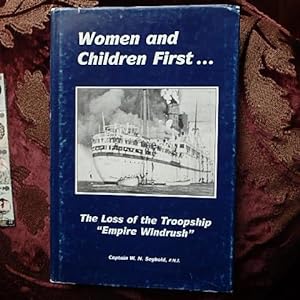captain w n seybold fni (1 Ergebnisse)
Produktart
- Alle Produktarten
- Bücher (1)
- Magazine & Zeitschriften
- Comics
- Noten
- Kunst, Grafik & Poster
- Fotografien
- Karten
-
Manuskripte &
Papierantiquitäten
Zustand
- Alle
- Neu
- Antiquarisch/Gebraucht
Einband
- alle Einbände
- Hardcover
- Softcover
Weitere Eigenschaften
- Erstausgabe
- Signiert
- Schutzumschlag
- Angebotsfoto
- Kein Print-on-Demand
Land des Verkäufers
Verkäuferbewertung
-
Women and Children First.: The Loss of the Troopship Empire Windrush
Verlag: Captain W.N. Seybold (Author), UK, 1998
ISBN 10: 0953354105ISBN 13: 9780953354108
Anbieter: Creaking Shelves Books, Spean Bridge, Vereinigtes Königreich
Verbandsmitglied: PBFA
Buch Erstausgabe
Original Black Boards. Zustand: Very Good. Zustand des Schutzumschlags: Near Very Good. 1st Edition. Empire Windrush is best remembered today for bringing one of the first large groups of post-war West Indian immigrants to the United Kingdom, carrying 1027 passengers and two stowaways on a voyage from Jamaica to London in 1948.[1][2] Of these, 802 passengers gave their last country of residence as somewhere in the Caribbean of whom 693 intended to settle in the United Kingdom.[1] British Caribbean people who came to the United Kingdom in the period after World War II are sometimes referred to as the Windrush generation. Empire Windrush set off from Yokohama, Japan, in February 1954 on what proved to be her final voyage. She called at Kure and was to sail to the United Kingdom, calling at Hong Kong, Singapore, Colombo, Aden and Port Said. Her passengers included recovering wounded United Nations veterans of the Korean War, some soldiers from the Duke of Wellington's Regiment wounded at the Third Battle of the Hook in May 1953. However, the voyage was plagued with engine breakdowns and other defects, including a fire after the departure from Hong Kong.[37] It took 10 weeks to reach Port Said, from where the ship sailed for the last time.[38] On board were 222 crew and 1276 passengers, including military personnel and some women and children, dependents of some of the military personnel.[39] At around 6:15am on Sunday March 28, there was a sudden explosion and fierce fire in the engine-room that killed the Third Engineer, two other members of the engine-room crew and the First Electrician; a fifth crew-member in the engine room and one in the boiler-room, both Greasers, managed to escape.[40] The ship quickly lost all electrical power as the four main electrical generators were located in the burning engine room; the back-up generator was started, but problems with the main circuit-breaker made its power unusable.[40] The ship did not have a sprinkler system. The Chief officer heard the explosion from the ship's bridge and assembled the ship's fire-fighting squad, who happened to be on deck at the time doing routine work. However they were only able to fight the fire for a few minutes before the loss of electrical power stopped the water pumps that fed their fire-hoses. The Second Engineer was able to enter the engine room by wearing a smoke hood, but was unable to close a water-tight door that might have contained the fire, due to a lack of electrical power. Attempts to close all water-tight doors using the controls on the bridge had also failed.[40] At 6:23am, the first distress calls were transmitted; further SOS calls used the emergency radio transmitter as electrical power had been lost. The order was given to wake the passengers and crew and assemble them at their emergency stations, but the ship's public address system was not working, nor were its air and steam whistles, so the order had to be transmitted by word-of-mouth. At 6:45am, all attempts to fight the fire were halted and the order was given to launch the lifeboats, with the first ones away carrying the women and children on-board.[40][39] Wreck location, off the coast of Algeria Wreck location, off the coast of Algeria Wreck location, in the Western Mediterranean off the coast of Algeria While the ship's 22 lifeboats could accommodate all on board, thick smoke and the lack of electrical power prevented many of them from being launched. Each set of lifeboat davits accommodated two lifeboats and without electrical power, raising the wire ropes to lower the second boat was an arduous and slow task. With fire spreading rapidly, the order was given to drop the remaining boats into the sea.[40] Many of the crew and troops on board abandoned the ship by climbing down ladders or ropes and jumping into the sea.[40] However, they were quickly picked up by Windrush's lifeboats and also by a boat from the first rescue ship, which reached the scene at 7.00am.[40][39] The ships responding to Windrush's distress call were the Dutch ship MV Mentor, the Brit.


